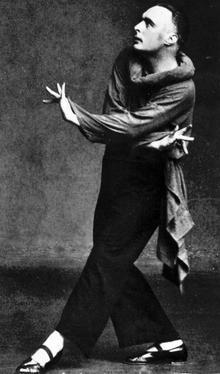You can help expand this article with text translated from the corresponding article in German. (January 2022) Click [show] for important translation instructions.
|
Rudolf von Laban | |
|---|---|
 | |
| Born | 15 December 1879 |
| Died | 1 July 1958 (aged 78) |
| Known for | Choreography, dance theory, Labanotation |
| Notable work | Labanotation (a movement notation system) |
| Movement | Expressionist dance |
| Partner | Lisa Ullman |
Rudolf (von) Laban, also known as Rudolph von Laban (Hungarian: Lábán Rudolf;[1] 15 December 1879 – 1 July 1958),[2] was an Austro-Hungarian dance artist, choreographer, and movement theorist. He is considered a "founding father of expressionist dance"[3] and a pioneer of modern dance.[4] His theoretical innovations included Laban movement analysis (a way of documenting human movement) and Labanotation (a movement notation system), which paved the way for further developments in dance notation and movement analysis. He initiated one of the main approaches to dance therapy.[5] His work on theatrical movement has also been influential.[6] He attempted to apply his ideas to several other fields, including architecture, education, industry, and management.[4]
Following a dress rehearsal of Laban's last choral work, Of the Warm Wind and New Joy, which he had prepared for the 1936 Summer Olympics in Berlin, Joseph Goebbels cancelled the piece[7] after which time Laban fell out of favor with the National Socialist government. He eventually left Germany for England in 1937 after four years of working with the Nazi regime.[8] Between 1945 and 1946, he and his long-term collaborator and former student Lisa Ullmann founded the Laban Art of Movement Guild in London, and the Art of Movement Studio in Manchester, where he worked until his death. The Trinity Laban Conservatoire of Music and Dance in London has continued this legacy.
- ^ An old source (Samuel Thornton, Laban's Theory of Movement: A New Perspective, Plays, 1971, p. 3) giving the birth name Lábán Rezső Keresztelő Szent János Attila is considered discredited and anecdotal as per Suzanne Walther, Dance of Death: Kurt Jooss and the Weimar Years, Routledge, 2013, p. 41 n. 11.
- ^ Vojtek, Miklós (1999). "Lábán Rudolf pozsonyi gyökerei" [The roots of Rudolf in Bratislava] (in Hungarian). Bratislava: Kalligram Publishing House. Retrieved 2022-01-31.
- ^ Dörr, Evelyn (2008). Rudolf Laban, The Dancer of the Crystal. Lanham, Maryland: Scarecrow Press. pp. 99–101. ISBN 9780810860070.
- ^ a b McCaw, Dick (2011). "The Laban Sourcebook". London, New York: Routledge Taylor & Francis. p. 1. ISBN 9780415543330.
- ^ Levy FJ (1988). "Laban movement analysis and dance therapy in the United States". Dance/movement therapy: a healing art (PDF). Reston, Va.: National Dance Association. pp. 131–164. ISBN 0-88314-380-1. Archived (PDF) from the original on 21 January 2022 – via Institute of Education Sciences.
- ^ Evans M (2009). Movement training for the modern actor (PDF). New York: Routledge. p. 17. ISBN 9780203883549. Archived (PDF) from the original on 2 November 2018 – via Coventry University.
- ^ Lilian Karina in Karina, Lilian; Marion Kant (2004). Hitler's Dancers: German Modern Dance and the Third Reich. Translated by Jonathan Steinberg. New York: Berghahn Books. p. 18.
- ^ Franco, Susanne (2012). "Rudolf Laban's Dance Film Projects". In Manning, Susan; Ruprecht, Lucia (eds.). New German Dance Studies. Chicago: University of Illinois Press. p. 64. ISBN 9780252078439.